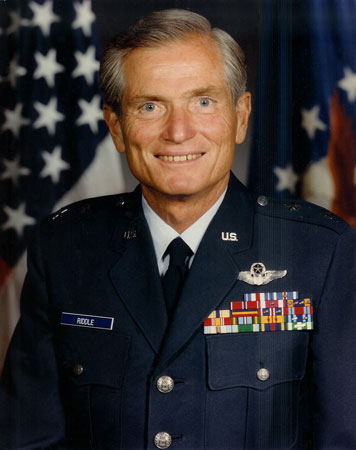
John Riddle
John Riddle was born in 1934 and raised in Indianapolis. After graduating from Broad Ripple High School, he attended Indiana University. Because IU is a land grant university, back in the 1950’s all male students were required to complete two years in the Reserve Officers Training Corps. While doing so, John found out he was qualified to attend military flight training. Remembering the World War II heroes of his youth, he decided to become an air force pilot.
With an IU marketing degree and an Air Force reserve commission in hand, 2nd Lt. John Riddle began basic pilot training in 1956. After his first flight in a T-34 Meteor, he knew he had made the right career choice. He graduated first in his class—both for academics and airmanship—a feat he repeated later at basic flight training.
After receiving his wings, John chose to fly the C-118 Liftmaster, a military version of the Douglas DC-6. Initially assigned to McGuire Air Force Base in New Jersey, he flew this aircraft world-wide. While serving as his wing commander’s aide-de-camp, John was offered and accepted, a regular commission.
Subsequently, John volunteered for duty in Southeast Asia where he flew another unarmed transport aircraft, the C-123 Provider.
In the first nights of 1968’s Tet Offensive, John was given a mission to pick-up some Vietnamese paratroopers and deliver them to reinforce a threatened special forces camp. To do so, he had to land his aircraft on an unlit dirt strip running up a hill. With only two barrels of oil on fire to mark the landing site, it took John two attempts to correctly align with that dirt strip and land. After taking off, he flew those paratroopers to an airport at the special forces camp. That airport was under heavy fire when he landed and later took off. For his actions that night, John Riddle was awarded our nation’s third highest military honor, the Silver Star.
Two weeks later, John flew into Khe Sanh, delivering supplies to the besieged garrison of Marines there. Khe Sanh is surrounded by hills. The North Vietnamese and Viet Cong occupied those hills and had the Marines under constant fire. During John’s approach to landing at Khe Sanh, his aircraft was struck repeatedly by enemy ground fire. John landed
on Khe Sanh’s damaged runway in minimum weather conditions due to rain and fog and while the field was under a mortar attack. For this, he received his first Distinguished Flying Cross.
A few months later, John flew a mission to drop ammunition to embattled ground forces at a heavily contested drop zone in the Mekong Delta. As he began the drop run, his plane was hit by ground fire and one engine had to be shut down. John continued the drop run on one engine and delivered critically needed ammunition to the ground forces. For successfully completing this mission, John was awarded a second Distinguished Flying Cross.
During his Viet Nam tour, John received other medals for meritorious service, including the Bronze Star. In all, he flew 1,127 sorties during 914 hours of combat flying.
Following his Viet Nam tour, John’s subsequent assignments saw him receive an early promotion to lieutenant colonel. However, a family emergency and a twist of fate led him to resign his commission in 1971 and become the President and General Manager of Dover Downs, a horse racing and motorsports complex in Dover, Delaware.
Two years later, John found himself missing the Air Force and itching to get back into his uniform. To scratch that itch, John accepted a reserve commission and became an Individual Mobilization Assistant. In that role, John was assigned to assist a succession of senior officers for the next 18 years.
During this period, while he advanced in rank, John changed jobs and became the Executive Vice-President of NASCAR and President of the Daytona International Speedway. Race weekends would usually see John flying one of NASCAR’s Rockwell Turbo Commander 690s to speedways around the country.
After serving in the Air Force Reserve for 18 years, John Riddle retired in 1991 as a Major General.
